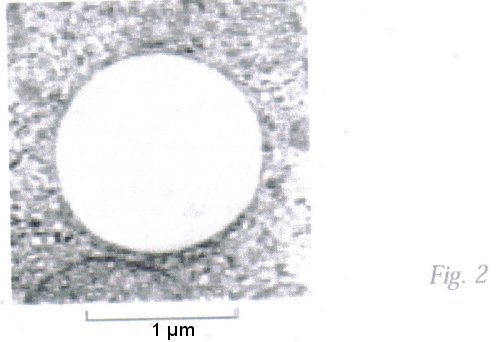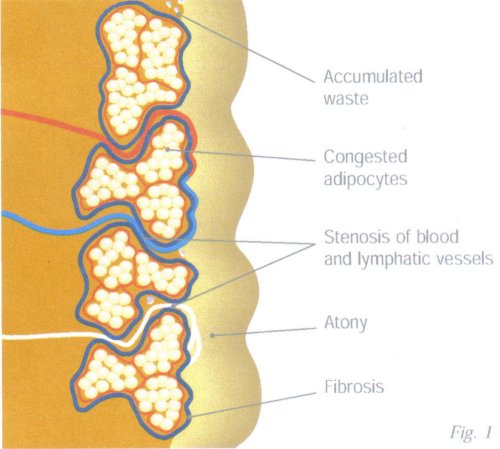CELLULYSE
A four stage treatment for cellulite
Cellulite is the development of degraded fatty tissue that frequently contains water. This disorder results from one or several factors such as poor arterial or venous circulation, hormonal disturbances and problems with lymphatic drainage. Cellulite is due to the excessive storage of fat in the adipocytes. By becoming heavily laden with lipids, the adipocytes swell and become hypertrophic, sometimes to a high degree. The compression of the blood and lymph vessels by these fatty masses induces poor drainage of the water and stagnation of the toxins in the tissues. The resul ring edema and degeneration of the fibers of the connective tissue lead to the typical irregular stippled appearence of the skin known as "orange skin" (Fig. 1).CELLULYSE is a complete treatment for cellulite. The concommitant use of or mixing with other products is contraindicated.
1. REDUCING LIPO-EDEMAS
The first step in efficiently treating cellulite consists in eliminating the excess water so as to reabsorb the edema and reduce swelling. CELLULYSE contains mannitol which has a diuretic effect. As a non metabolizable carbohydrate, it is excreted via the renal glomeruli without being absorbed by the tubules. This necessarily results in the eliminatlon of a certain amount of water. It is used here instead of certain vegetal extracts such as Cynara scolymus (artichoke) which is sometimes used in phytotherapy.2. RESTORING AN EFFICIENT MICRO-
CIRCULATION
Cellulite is frequently associated with circulation problems. The adipocytes, swollen by an excessive accumulation of fat exert pressure on the arterial, venous and lymphatic net-works which surround them (Fig. 1).
It is therefore essential to restore an efficient micro-circulation in order to re-establish the phenomena of tissue exchange (nutritional supply, excretion of waste substances, storage and release) which ensure good tissue function. Thanks to the vasodilatory activity of PTMPB [4-(-1-Pyrrolidinyl)-1-(2,4,6-trimethosyphenyl)-1-butanone], CELLULYSE helps to increase blood flow and therefore to irrigate and oxygenate the tissues. It restores an efficient functional micro circulation by opening the spasmed pre-capillary sphincters at the expense of the arteriovenous shunts. Derivatives of the flavonosides such äs rutin offer a particularly beneficial vasculo-protective effect in this respect. They increase the resistance of the capillaries directly by stabilizing the vascular basal membrane and indirectly by the uptake of free radicals. Thanks to its antioxidant properties, Vitamin C is essential for neutralizing the effect of the free radicals generated in the newly oxygenated tissues (reperfusion syndrome).
3. LIPOLYSIS
Tween associated with γ-cyclodextrin forms an amphoteric complex which is both liposoluble and hydrosoluble. It is capable of bonding aqueous and lipidic phases which nor mally cannot be mixed. When carried to the adipocytes by interstitial liquids, it lyzes the membrane by solubilizing the lipidic layer. The lipidic droplets contained in the cytosol of these cells are then relased into the intercellular space (Fig. 2).
Like its analogues caffeine and aminophyllin, theophyllin acts by inhibiting phosphodiesterase (PDE). This process maintains a high level of cyclic AMP, thus stimulating the natural lipolytic mechanisrns of the adipocytes.
Once released, the short chain fatty acids pass into the circulation while the long-chain fatty acids bind to albumin. The free fatty acids may then be used as a source of energy by all the tissues except the brain and the erythrocytes.
Their degradation is particularly intense in the liver if the serum concentration is high.The remaining lipid complexes are placed in Suspension by the Tween γ-cyclodextrin complex to form chylomicrons which are released into the circulation via the lymphatic system. Since they are small, they are processed by the liver, and the fenestrated capillaries allow them to leave their vascular bed and pass into Disse's space.
Another amphoteric complex frequently used elsewhere is phosphatidylcholine extracted from soya or egg. However, the Tween γ-cyclodextrin combination was preferred here because it does not present the same allergic risk.
Thiomucase has sometimes been used for its chondroitinasic and hyaluronidasic activity. By inducing the depolymerization of the basal substance of the connective tissue, it loosens the connective partitions, supposedly increasing the absorption and diffusion of substances administered and the excretion of waste. Unlike thiomucase, the Tween γ-cyclodextrin complex does not destructure the connective tissue, so does not lead to excessive slackening of the skin.4. RESTRUCTURING AND PROTECTING
THE CONNECTIVE TISSUE
When efficient, the treatment of cellulite leads to a considerable decrease in the volume of fatty tissues. When fat has accumulated over a period of years, the distended connective tissue no longer possesses the elasticity required for recovering its initial tone.
By modifying both qualitatively and quantitatively the elastin, silicium stimulates the regeneration of connective tissue. In addition, it tends to form a tri-dimensional network, hence its value in structuring these tissues.
Once regenerated and restructured, the connective tissue recovers its tone and elasticity. For this reason, CELLULYSE may be complemented by a restructuring treatment such as CELLULIFT, which helps to restructure atonic and/or sagging tissues.
